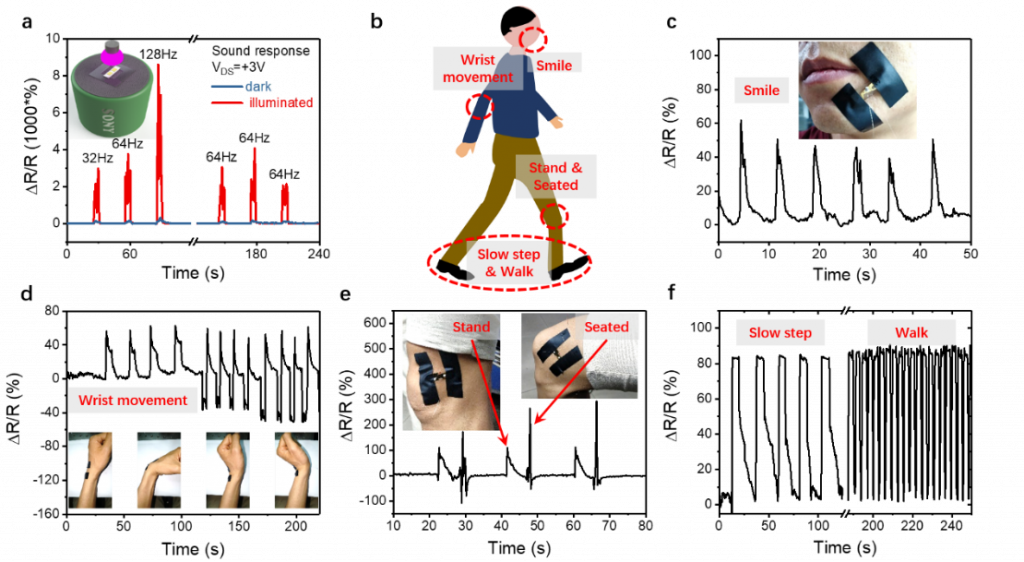張慶瑞教授與吳育任教授團隊參與國際合作之柔性電子學研究榮登《Nature Communications》期刊 (NTU scientists develop giant gauge device of flexible electronics)
台灣大學應用物理研究所與電子工程學研究所張慶瑞教授及其博士生傅薈如教授(現任教於元智大學),電機系暨光電所吳育任教授及其博士生蔡宗印以及高雄科技大學電子工程系洪冠明教授共同參與國際團隊合作,發展了一種利用凡得瓦層狀材料提高應變感測器應變靈敏度因數的方法,相對於金屬材料至少提高了500倍以上的靈敏度。通過利用壓電效應和光電效應的交互作用,除了應變靈敏係數提高外,也同時提高應變靈敏度因數的可調節範圍,並且具體展示了其在人體日常運動捕捉微小振動感知方面的應用,在柔性電子學的原理與應用上有重要貢獻。該創新成果『凡得瓦層狀材料之巨大應變靈敏係數感應器』研究,於四月一日發表在《自然》子刊Nature Communications上。
價值與潛力
近年來,軟體機器人、遠端監控、人工智慧和可穿戴醫療設備發展迅速,對應變感測器的柔韌性、靈敏度和低功耗有了更高的要求。目前,商用應變感測器主要基於金屬材料。但是金屬沒有能隙,因此金屬應變感測器的應變靈敏度因數一般會侷限在1-5的小範圍內。傳統半導體的能隙應變雖然可調,但是傳統半導體材料通常很脆,也限制了其在穿戴式設備的應變探測範圍。相比于金屬材料和傳統半導體材料,凡得瓦層狀半導體材料具有優良的柔韌性、光電特性和壓電特性,在能源儲存、光電、傳感、可穿戴設備等方面有巨大的應用前景。基於此,本跨國際與跨領域的合作團隊提出了基於凡得瓦層狀半導體材料的柔性應變感測器。通過壓電效應和光電效應的共同作用調節載流子的濃度和遷移率,首次實現了應變靈敏度因數可在高達23-3933區間內連續可調。此外,如下圖所展示,該凡得瓦柔性感測器可以檢測聲音引起的微小振動和監測人體日常運動,充分展示了其在機器人、遠端監控、人工智慧和可穿戴醫療等領域潛在的應用前景。

圖1凡得瓦層狀材料應變感測器在聲音引起的微小振動及人體日常運動監控領域應用。
此課題結合能帶計算,二維材料,光學與電路設計,並進而在柔性電子的穿戴裝置上得到具體驗證,要感謝科技部長期支持跨領域的科技研究,而本研究後續的應用發展更值得期待。
NTU scientists develop giant gauge device of flexible electronics
Professor Chang Ching-Ray from the Institute of Applied Physics and the Institute of Electronic Engineering, National Taiwan University and his doctoral student Professor Fuh Huei-Ru (currently teaching at Yuanzhi University), Professor Wu Yuh-Renn from the Department of Electrical Engineering and Optoelectronics and his Ph.D student Tsai Tsung-Yin, and the Department of Electronic Engineering, Kaohsiung University of Science and Technology Professor Hung Kuan-Ming participated in international team. Recently they developed a method to improve the Gauge factor of strain sensors by using Van der Waals layered materials, which increased the sensitivity by at least 500 times compared with metal materials. By using the mutual interaction of the piezoelectric effect and the photoelectric effect, in addition to the improvement of the Gauge factor, the adjustable range of the Gauge factor is also improved, and it specifically demonstrates its application in the daily activities of the human body to capture small vibration perception. There are important contributions to the principles and applications of learning. The innovative result “Giant Gauge factor of Van der Waals material based strain sensors” was published in Nature Communications on April 1st.
In recent years, software robots, remote monitoring, artificial intelligence, and wearable medical instruments have developed rapidly, and there are higher requirements for the flexibility, sensitivity, and low power consumption of the corresponding sensor. Currently, commercial strain sensors are mainly based on metal materials. However, metal has no energy gap, so the gauge factor of a metal strain sensor is generally limited to a small range of 1-5. Although the energy gap strain of traditional semiconductors is adjustable, traditional semiconductor materials are usually very brittle, which also limits the strain detection range of wearable devices. Compared with metal materials and traditional semiconductor materials, Van der Waals layered semiconductor materials have excellent flexibility, optoelectronic properties and piezoelectric properties, and have huge application prospects in energy storage, optoelectronics, sensing, and wearable devices. Based on this, this cross-international and cross-field team proposed a flexible strain sensor based on Van der Waals layered semiconductor materials. Through the mutual interaction of the piezoelectric effect and the photoelectric effect to adjust the concentration and mobility of carriers, it is the first time that the gauge factor can be continuously adjusted in the range of 23-3933. In addition, as shown in the figure below, the Van der Waals flexible sensor can detect tiny vibrations caused by sound and monitor daily human activities, fully demonstrating its potential applications in robotics, remote monitoring, artificial intelligence, and wearable medical care. prospect.
Wenjie Yan, Huei-Ru Fuh, Yanhui Lv, Ke-Qiu Chen, Tsung-Yin Tsai, Yuh-Renn Wu, Tung-Ho Shieh, Kuan-Ming Hung*, Juncheng Li, Duan Zhang, Cormac Ó Coileáin, Sunil K. Arora, Zhi Wang, Zhaotan Jiang, Ching-Ray Chang, and Han-Chun Wu*,“Giant Gauge factor of Van der Waals material based strain sensors”,Nature Communications volume 12, Article number: 2018 (2021).
文章連結:https://www.nature.com/articles/s41467-021-22316-8
